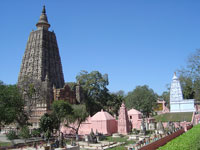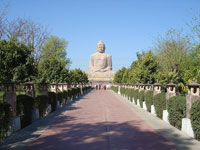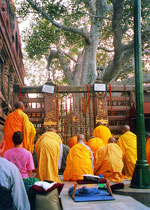Places of Interest
INDIA
Buddhism in IndiaBihar
Bihar is a state of the Indian union situated in north India. Its capital is Patna. Formerly known as Magadha, it was once the center power of India's struggle for Independence. The Name Bihar is derived from the Sanskrit word, 'Vihara' which means monasteries. It was also an important center of Education, culture and tradition. The state's capital Patna, is a pleasant city of less than a million people.
 << The Mahabodhi Temple in Patna, Bihar
<< The Mahabodhi Temple in Patna, Bihar
Bihar lies in the very fertile Indo-Gangetic Plain. It is a rich and fertile land with a mild climate and is crossed by many major rivers, including the Ganges. Bihar is bounded on the north by Nepal, on the south by Jharkhand, on the east by West Bengal and on the west by Uttar Pradesh. Culturally, it is a part of the Hindi heartland of India. Bihar is also the birth place of the first president of India, Dr. Rajendra Prasad.
History
In the 6th century BC the Magadhas ruled in the area. Their leader, King Bimbisara, was converted to Buddhism by the Buddha himself. The Magadhas were defeated in 321 BC by Chandra Gupta Maurya, the first Mauryan emperor.
Based in Pataliputra, as Patna was then called, this great ruler expanded the Mauryan empire as far as the Indus River. His grandson was Ashoka, a brilliant leader and another famous convert to Buddhism, who expanded the empire even further. Having embraced Buddhism under a succession of rulers, the assumption of control by the Gupta dynasty in the 4th century marked the return of Hinduism to the area.
Towards the end of the 1100s the Muslim Sultanate gained control of the region. By the end of the 15th century the Moghuls ruled all of North India including what is now Bihar. They in turn succumbed eventually to the British, until, at Independence, Bihar took its present form.
Buddhism in Bihar
Bihar is considered as the cradle and fount of the emergence of Buddhism. The state is home to Bodhgaya, the location where Buddha attained supreme Enligtenment (Nirvana). Unfortunately, while Bihar is a state has some of the most holy pilgrimage centres for Buddhist, Hindu, Jain, Sikh and Sufi faiths, it is one of India's poorest and most lawless states. Visitors are advised to take special precaution with regards to their personal safety when travelling through this region.
when travelling through this region.
Bodhgaya - where the Buddha attained enlightenment - is, internationally, the most important Buddhist pilgrimage place. It is here that the direct descendent of the bodhi (peepal) tree under which Buddha sat, grows and is revered. (A sapling of the actual tree was taken to Sri Lanka by the daughter of the Mauryan emperor and Buddhist convert Ashoka. The current tree is from a sapling from that tree which was in turn brought back to Bodhgaya and planted.)
 The ancient university Nalanda is situated in Bihar and its ruins can still be seen there. Located near Patna, the ancient Buddhist university was established by the Guptas in the 5th century AD. A description from the 7th century reports 10,000 monks and students living and studying there, including many from other countries. Attacked and burned by Afghani Muslims in the 12th century, it is now an extensive ruin.
The ancient university Nalanda is situated in Bihar and its ruins can still be seen there. Located near Patna, the ancient Buddhist university was established by the Guptas in the 5th century AD. A description from the 7th century reports 10,000 monks and students living and studying there, including many from other countries. Attacked and burned by Afghani Muslims in the 12th century, it is now an extensive ruin.
<< The Sacred Bodhi Tree
At Rajgir, near Nalanda, the first Buddhist council was held after the Buddha attained enlightenment. At the time capitol of the area, Rajgir was the Buddha's home for twelve years.
At Vaishali, near Patna, it is said that Buddha preached his last sermon before he died. It is believed that a silver urn in a stupa in this city contains his ashes.
Reference:
1) Wikipedia
2) Indax - India Web Site
 << The Mahabodhi Temple in Patna, Bihar
<< The Mahabodhi Temple in Patna, BiharBihar lies in the very fertile Indo-Gangetic Plain. It is a rich and fertile land with a mild climate and is crossed by many major rivers, including the Ganges. Bihar is bounded on the north by Nepal, on the south by Jharkhand, on the east by West Bengal and on the west by Uttar Pradesh. Culturally, it is a part of the Hindi heartland of India. Bihar is also the birth place of the first president of India, Dr. Rajendra Prasad.
History
In the 6th century BC the Magadhas ruled in the area. Their leader, King Bimbisara, was converted to Buddhism by the Buddha himself. The Magadhas were defeated in 321 BC by Chandra Gupta Maurya, the first Mauryan emperor.
Based in Pataliputra, as Patna was then called, this great ruler expanded the Mauryan empire as far as the Indus River. His grandson was Ashoka, a brilliant leader and another famous convert to Buddhism, who expanded the empire even further. Having embraced Buddhism under a succession of rulers, the assumption of control by the Gupta dynasty in the 4th century marked the return of Hinduism to the area.
Towards the end of the 1100s the Muslim Sultanate gained control of the region. By the end of the 15th century the Moghuls ruled all of North India including what is now Bihar. They in turn succumbed eventually to the British, until, at Independence, Bihar took its present form.
Buddhism in Bihar
Bihar is considered as the cradle and fount of the emergence of Buddhism. The state is home to Bodhgaya, the location where Buddha attained supreme Enligtenment (Nirvana). Unfortunately, while Bihar is a state has some of the most holy pilgrimage centres for Buddhist, Hindu, Jain, Sikh and Sufi faiths, it is one of India's poorest and most lawless states. Visitors are advised to take special precaution with regards to their personal safety
 when travelling through this region.
when travelling through this region. Big Buddha in Bodh Gaya >>
Bodhgaya - where the Buddha attained enlightenment - is, internationally, the most important Buddhist pilgrimage place. It is here that the direct descendent of the bodhi (peepal) tree under which Buddha sat, grows and is revered. (A sapling of the actual tree was taken to Sri Lanka by the daughter of the Mauryan emperor and Buddhist convert Ashoka. The current tree is from a sapling from that tree which was in turn brought back to Bodhgaya and planted.)
 The ancient university Nalanda is situated in Bihar and its ruins can still be seen there. Located near Patna, the ancient Buddhist university was established by the Guptas in the 5th century AD. A description from the 7th century reports 10,000 monks and students living and studying there, including many from other countries. Attacked and burned by Afghani Muslims in the 12th century, it is now an extensive ruin.
The ancient university Nalanda is situated in Bihar and its ruins can still be seen there. Located near Patna, the ancient Buddhist university was established by the Guptas in the 5th century AD. A description from the 7th century reports 10,000 monks and students living and studying there, including many from other countries. Attacked and burned by Afghani Muslims in the 12th century, it is now an extensive ruin.<< The Sacred Bodhi Tree
At Rajgir, near Nalanda, the first Buddhist council was held after the Buddha attained enlightenment. At the time capitol of the area, Rajgir was the Buddha's home for twelve years.
At Vaishali, near Patna, it is said that Buddha preached his last sermon before he died. It is believed that a silver urn in a stupa in this city contains his ashes.
Reference:
1) Wikipedia
2) Indax - India Web Site



